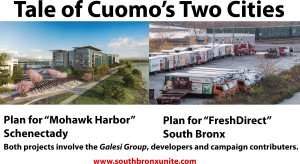The hunger for environmental justice in New York City was in evidence at a recent public hearing of the City Council that was so crowded that people were forced to wait in a lobby. The Council is considering two bills (Intro No.s 359 & 886) to create an interagency task force and an advisory board to address these issues, as well as authorizing an analysis on ways to reduce the burden of polluting industries on saturated neighborhoods.
Full article here.

Looking Northwest from 29th Street, June 2000, Negative: 2000; Print: 2009 © Joel Sternfeld; Courtesy of the artist and Luhring Augustine, New York.
Before the Fedex facility was moved to Port Morris, it was located in Chelsea, behind where the Highline was being designed. Activists say the use of generous taxpayer subsidies to move polluting operations to the South Bronx is an example of environmental injustice.
Throughout the city, low-income communities of color with limited access to parks and the waterfront shoulder an unfair proportion of toxic facilities. Although it is encouraging that the Committee on Environmental Protection under the leadership of Councilman Costantinides is dedicating attention to this vital issue, residents in affected areas already know very well what the root of the problem is: impacted communities are rarely consulted, and when they are their role is merely advisory.
As many in these communities can attest, there have been enough studies and task forces on environmental justice. We need restorative action now. Enforceable mandates and regulations are urgently needed to reverse the disproportionate impacts polluting facilities have had on these communities.
Some tangible steps the city could take to ameliorate these injustices include:
Limiting the amount of garbage each of the five boroughs processes to 20% Restricting the number and acreage of power plants allowed in any Community District
Capping the number of industries with fleets of diesel trucks or perchloroethylene dry cleaning facilities in any neighborhood
Planting 100 trees for each ton of particle soot or Nitrogen Oxide emissions, and creating an acre of open space for every 50 units of residential development
Reverse the Mayor’s ban on housing in the 21 Industrial Business Zones, which relegates swaths of the City as EJ dumping grounds, especially Port Morris and Hunt’s Point
The Council should also move to reform the city’s Kafkaesque land use review process, ULURP, which fails to account for the cumulative impacts caused by projects introduced into neighborhoods already glutted with polluting facilities.
EJ communities have become the dumping grounds for unwanted industrial uses. FedEx was relocated from Manhattan’s lucrative Highline area, and foisted on the South Bronx waterfront, right next to a gargantuan NY Post facility, and its sizable trucking fleet. For another example, the controversial Bronx Terminal Market and Yankee Stadium projects were each considered independently of the other with no coordinated assessment of the impact the increased traffic and lost open space would have on the surrounding community.
As proposed, the advisory board would consist of an astounding 17 members appointed by one person, the Speaker of the Council. What if in the future that person is not an ally? For long-term success and greater stakeholder engagement, these appointments could be more evenly distributed between borough presidents, community boards and others, and should reflect the communities they represent.

The task force, as proposed, does not include representatives from the NYC Economic Development Corporation or the related Industrial Development Agency. It should. Those agencies often hide behind opaque decision-making processes to give away cash grants and tax breaks to polluting low wage industries, such as FreshDirect, to which the EDC offered one of the largest subsidy packages ever, at the expense of our community’s health.
There are cautionary tales the Council can draw from in creating an effective advisory board. For instance, The New York Power Authority has an Environmental Justice Task Force, but it meets sporadically and offers scant information online. Troublingly, not a single Port Morris resident serves on it, even though government agencies have temporarily permitted not one but FOUR power plants on prime waterfront real estate, thwarting the community’s aspirations of opening up recreation and mixed-use areas along the riverfront. The public will have to be watchful to ensure that any new entity does not become an instrument for the creation of pet projects in more politically connected areas of the city.
The law needs to be clearer about meeting times and accessible locations. As presently proposed, it would meet twice annually. If these issues are to be considered seriously, that is inadequate. Advocates have made other suggestions lawmakers should address as the bills are finalized. Organizing more meetings where there’s room for everyone at times that are convenient to the public would be a good step.
Harry Bubbins is a founder of Friends of Brook Park.